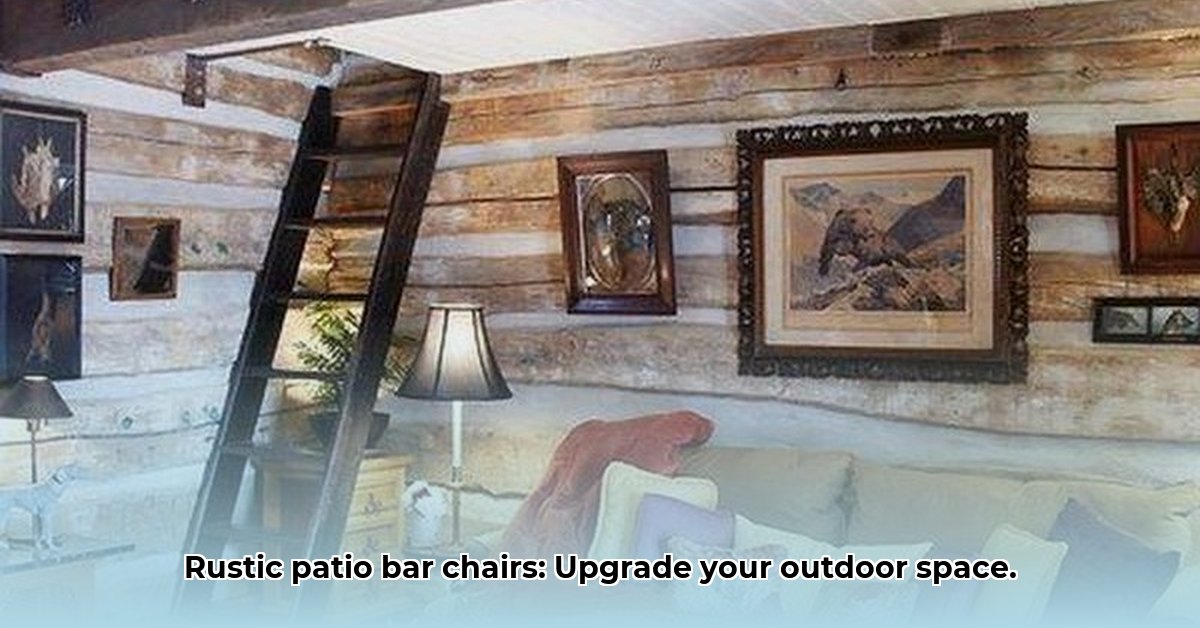Imagine yourself outdoors, a cool drink in hand, watching the sunset. What could elevate this moment? The perfect rustic bar chairs! This guide provides a comprehensive overview of selecting the ideal chairs for your patio or deck. We’ll explore materials, styles, retailers, and care tips to help you create an inviting outdoor space that lasts for years. For more wrought iron options, check out these [stylish patio chairs](https://www.wavesold.com/rod-iron-patio-chairs/).
Rustic Bar Chairs: Transform Your Patio in 2025
Picture long summer evenings filled with laughter, as friends and family relax on comfortable, stylish rustic bar chairs. Choosing the right bar chairs is essential for upgrading your patio, turning it into a welcoming hub for relaxation and entertainment.
Selecting the Right Materials: Balancing Beauty and Durability
The choice of materials significantly impacts both the appearance and lifespan of your chairs. Let’s explore your options:
- Wood: Timeless Warmth: Wood adds a natural, inviting feel. Cedar and teak are excellent choices for outdoor use due to their natural resistance to rot and insects. Regular oiling or sealing is necessary to protect them from the elements and maintain their beauty.
- Metal: Modern Strength: Powder-coated steel or wrought iron offers a durable, industrial-chic aesthetic. Metal is highly resistant to rust and can withstand harsh weather. However, be aware that metal can become hot in direct sunlight. Consider cushions for added comfort.
- Mixed Materials: The Best of Both Worlds: Combining wood and metal creates unique, eye-catching designs that offer a balance of both aesthetics and resilience. These chairs often provide the warmth of wood with the strength and durability of metal.
- Recycled Plastic (HDPE): High-Density Polyethylene (HDPE) lumber is a fantastic eco-friendly option that mimics the look of wood but is incredibly durable and requires virtually no maintenance. It resists fading, cracking, and splintering, making it perfect for harsh climates.
Consider your personal style and local climate when choosing materials.
Styles and Designs: Matching Functionality to Aesthetics
Selecting the right style is critical for both comfort and the overall look of your patio:
- Backrests: Comfort vs. Space: Chairs with backrests offer superior comfort, ideal for leisurely gatherings. Backless stools are more space-efficient, making them suitable for smaller patios or bars.
- Height: Getting it Right: Standard bar stools are typically 30 inches tall and designed for bars that are 41 to 43 inches high. Counter-height stools are around 24-26 inches tall and paired with counters that are 35-37 inches high. Always measure your bar or counter height before purchasing.
- Design Details: Adding Personality: Distressed finishes, intricate carvings, metal accents, and unique upholstery can all enhance the visual appeal of your patio. Consider your existing outdoor décor when selecting design elements.
- Swivel vs. Stationary: Swivel stools allow for easy conversation and movement, while stationary stools offer a more stable and grounded feel.
- Arms or Armless: Bar stools with arms provide additional comfort and support, but they may take up more space. Armless stools are more compact and offer a cleaner look.
Explore different styles and designs to find the perfect fit for your outdoor space.
Rustic Bar Chair Buying Guide: A Step-by-Step Approach
Investing in outdoor furniture requires a thoughtful approach. Follow these steps for a successful purchase:
- Set a Budget: Determine your spending limit. Rustic bar chair prices vary widely based on materials, design, and brand. Don’t forget to factor in potential shipping costs or assembly fees.
- Measure Your Space: Accurately measure your patio or deck area to ensure adequate space for the chairs and comfortable movement. Consider the space needed when chairs are pulled out.
- Define Your Needs: Determine the number of chairs you need, backrest preferences, height requirements, and desired features (e.g., swivel, arms). Think about how you plan to use the space and how many people you typically entertain.
- Evaluate Materials: Choose weather-resistant materials that can withstand sun, rain, humidity, and temperature fluctuations in your local climate. Consider the maintenance requirements of each material.
- Read Reviews: Check online reviews to get insights from other customers regarding the quality, comfort, and durability of different chairs. Pay attention to both positive and negative feedback.
- Compare Prices: Shop around at different retailers to find the best deals. Look for sales, discounts, and promotions.
- Check Return Policies: Ensure that the retailer has a clear and reasonable return policy in case you are not satisfied with your purchase.
- Plan for Assembly: Check whether the chairs require assembly upon arrival. If so, assess your ability to assemble them yourself or factor in the cost of professional assembly.
Choosing Retailers for Your Patio Chairs
Consider the following retailer options:
- Online Retailers: Sites like Amazon, Wayfair, and specialized furniture retailers offer a vast selection, convenient browsing, and customer reviews. However, you can’t physically inspect the quality before buying, and shipping costs can be significant.
- Local Furniture Stores: Local stores provide opportunities to see and feel the chairs in person, receive expert advice from sales representatives, and support local businesses. However, the selection may be more limited, and prices might be higher.
- Custom Makers: Custom-made chairs allow for complete personalization and the highest level of quality. However, they come at a premium price and may require a longer lead time.
- Consignment Shops/Antique Stores: These can be great for unique, vintage pieces that add character to your patio. Selection is unpredictable, but you may find a hidden gem.
Decide whether you prefer the convenience of online shopping or the hands-on experience of a physical store.
Maintenance for Longevity
Proper care is essential for extending the lifespan of your outdoor chairs:
- Wooden Chairs: Clean regularly with mild soap and water. Apply oil or sealant annually to prevent cracking, warping, and fading. Store indoors or cover during harsh weather.
- Metal Chairs: Wipe down regularly to remove dirt and debris. Touch up any rust spots with rust-resistant paint. Apply a protective coating to prevent future rust.
- Recycled Plastic (HDPE) Chairs: These require minimal maintenance. Simply wash with soap and water as needed. They are highly resistant to stains and fading.
- All Chair Types: Use protective covers during periods of heavy rain, snow, or prolonged sun exposure. Store chairs indoors during the off-season to protect them from the elements.
Regular maintenance will keep your outdoor seating looking beautiful and functioning properly for years to come.
Pros and Cons of Different Rustic Bar Chair Materials (Summarized)
| Material | Pros | Cons |
|---|---|---|
| Wood | Natural beauty, warm feel, wide range of styles, renewable resource | Requires regular maintenance, susceptible to weathering, can be expensive |
| Metal | Durable, low maintenance, modern and industrial styles, rust-resistant (if properly coated) | Can get very hot in direct sunlight, can be uncomfortable without cushions |
| Mixed Materials | Combines the best of wood and metal aesthetics & durability, unique designs | Often more expensive than wood or metal-only options, maintenance requirements can be complex |
| Recycled Plastic (HDPE) | Extremely durable, low maintenance, weather-resistant, eco-friendly, resists fading and cracking | May not have the same aesthetic appeal as wood or metal, can be more expensive than some options |
Choosing high-quality rustic bar chairs and maintaining them properly will enhance your patio and extend the life of your furniture. Consider your aesthetic preferences, budget, and maintenance capabilities to create the perfect outdoor space for your needs.
How to Choose the Most Durable Rustic Outdoor Bar Stools for Longevity
Durability is paramount for outdoor bar stools due to constant exposure to the elements.
Key Takeaways:
- Comfort, durability, style, and budget are essential factors.
- Material choice significantly impacts longevity and maintenance.
- Consider your local climate when selecting materials and designs.
Types of Rustic Bar Stools: Material Matters
Your style preferences, combined with durability considerations, are key.
- Wood: Teak and cedar are naturally rot and insect-resistant. However, regular sealing is crucial, especially in humid climates. Consider the source of the wood – is it sustainably harvested?
- Metal: Aluminum is lightweight and rust-resistant, ideal for coastal environments. Steel offers superior strength but requires powder coating to prevent rust. Wrought iron provides a classic look but needs regular maintenance.
- Wicker/Rattan: Natural wicker and rattan are beautiful but less weather-resistant. Synthetic wicker (resin wicker) is a more durable alternative. Protect natural wicker from rain and intense sun.
- Concrete: Increasingly popular, concrete bar stools offer a modern industrial look that’s incredibly durable. However, they are very heavy and difficult to move. They can also be cold to sit on.
A Rustic Bar Stool Buying Guide: Practical Considerations
Follow this step-by-step approach to make an informed decision:
Step 1: Measure Your Space: Ensure proper seating ergonomics and comfortable movement around the bar or patio. Consider the footprint of the stools when fully extended.
Step 2: Prioritize Durability: Research materials that withstand your
- Modern Kitchen Backsplash Ideas To Inspire Your Refresh - December 19, 2025
- Modern Backsplash Ideas: A Guide to Todays Kitchen Trends - December 18, 2025
- Ceramic Kitchen Wall Tiles: Style and Protection for Your Walls - December 17, 2025









